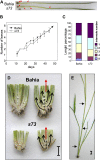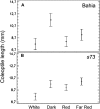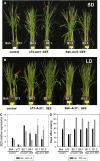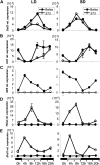Analysis of PHOTOPERIOD SENSITIVITY5 sheds light on the role of phytochromes in photoperiodic flowering in rice
- PMID: 19675157
- PMCID: PMC2754645
- DOI: 10.1104/pp.109.139097
Analysis of PHOTOPERIOD SENSITIVITY5 sheds light on the role of phytochromes in photoperiodic flowering in rice
Abstract
A great number of plants synchronize flowering with day length. In rice (Oryza sativa), photoperiod is the primary environmental cue that triggers flowering. Here, we show that the s73 mutant, identified in a gamma-irradiated Bahia collection, displays early flowering and photoperiodic insensitivity due to a null mutation in the PHOTOPERIOD SENSITIVITY5 (SE5) gene, which encodes an enzyme implicated in phytochrome chromophore biosynthesis. s73 mutant plants show a number of alterations in the characteristic diurnal expression patterns of master genes involved in photoperiodic control of flowering, resulting in up-regulation of the floral integrator Heading date3a (Hd3a). Early heading date1 (Ehd1), an additional rice floral activator, was also highly expressed in the s73 mutant, suggesting that SE5 represses Ehd1 in wild-type plants. Silencing of Ehd1 in both Bahia and s73 backgrounds indicated that SE5 regulates Ehd1 expression. The data also indicate that SE5 confers photoperiodic sensitivity through regulation of Hd1. These results provide direct evidence that phytochromes inhibit flowering by affecting both Hd1 and Ehd1 flowering pathways.
Figures








Similar articles
-
Transcriptional and post-transcriptional regulation of heading date in rice.New Phytol. 2021 May;230(3):943-956. doi: 10.1111/nph.17158. Epub 2021 Feb 14. New Phytol. 2021. PMID: 33341945 Free PMC article. Review.
-
Molecular dissection of the roles of phytochrome in photoperiodic flowering in rice.Plant Physiol. 2011 Nov;157(3):1128-37. doi: 10.1104/pp.111.181792. Epub 2011 Aug 31. Plant Physiol. 2011. PMID: 21880933 Free PMC article.
-
Post-transcriptional regulation of Ghd7 protein stability by phytochrome and OsGI in photoperiodic control of flowering in rice.New Phytol. 2019 Oct;224(1):306-320. doi: 10.1111/nph.16010. Epub 2019 Jul 19. New Phytol. 2019. PMID: 31225911
-
Phytochromes confer the photoperiodic control of flowering in rice (a short-day plant).Plant J. 2000 Jun;22(5):391-9. doi: 10.1046/j.1365-313x.2000.00753.x. Plant J. 2000. PMID: 10849355
-
Research progress of photoperiod regulated genes on flowering time in rice.Yi Chuan. 2016 Jun 20;38(6):532-542. doi: 10.16288/j.yczz.15-478. Yi Chuan. 2016. PMID: 27655315 Review.
Cited by
-
OsPhyA modulates rice flowering time mainly through OsGI under short days and Ghd7 under long days in the absence of phytochrome B.Plant Mol Biol. 2016 Jul;91(4-5):413-27. doi: 10.1007/s11103-016-0474-7. Epub 2016 Apr 2. Plant Mol Biol. 2016. PMID: 27039184
-
Characterization of epistatic interaction of QTLs LH8 and EH3 controlling heading date in rice.Sci Rep. 2014 Mar 3;4:4263. doi: 10.1038/srep04263. Sci Rep. 2014. PMID: 24584028 Free PMC article.
-
The histone methyltransferase SDG724 mediates H3K36me2/3 deposition at MADS50 and RFT1 and promotes flowering in rice.Plant Cell. 2012 Aug;24(8):3235-47. doi: 10.1105/tpc.112.101436. Epub 2012 Aug 14. Plant Cell. 2012. PMID: 22892321 Free PMC article.
-
A point mutation in the zinc finger motif of RID1/EHD2/OsID1 protein leads to outstanding yield-related traits in japonica rice variety Wuyunjing 7.Rice (N Y). 2013 Oct 18;6(1):24. doi: 10.1186/1939-8433-6-24. Rice (N Y). 2013. PMID: 24280027 Free PMC article.
-
Transcriptional and post-transcriptional regulation of heading date in rice.New Phytol. 2021 May;230(3):943-956. doi: 10.1111/nph.17158. Epub 2021 Feb 14. New Phytol. 2021. PMID: 33341945 Free PMC article. Review.
References
-
- Biswas KK, Neumann R, Haga K, Yatoh O, Iino M (2003) Photomorphogenesis of rice seedlings: a mutant impaired in phytochrome-mediated inhibition of coleoptile growth. Plant Cell Physiol 44: 242–254 - PubMed
-
- Conesa A, Gotees S, García-Gómez JM, Terol J, Talon M, Robles M (2005) Blast2GO: a universal annotation and visualization tool in functional genomics research. Application note. Bioinformatics 21: 3674–3676 - PubMed
-
- Corbesier L, Vincent C, Jang S, Fornara F, Fan Q, Searle I, Giakountis A, Farrona S, Gissot L, Turnbull C, et al (2007) FT protein movement contributes to long-distance signaling in floral induction of Arabidopsis. Science 316: 1030–1033 - PubMed
-
- Domingo C, Andrés F, Iglesias D, Tharreau D, Talón M (2009) Depletion of auxin content mediated by OsGH3.1 overexpression activates defense response and enhances resistance to fungal pathogen in rice. Mol Plant Microbe Interact 22: 201–210 - PubMed
Publication types
MeSH terms
Substances
Associated data
- Actions
LinkOut - more resources
Full Text Sources
Molecular Biology Databases
Miscellaneous

